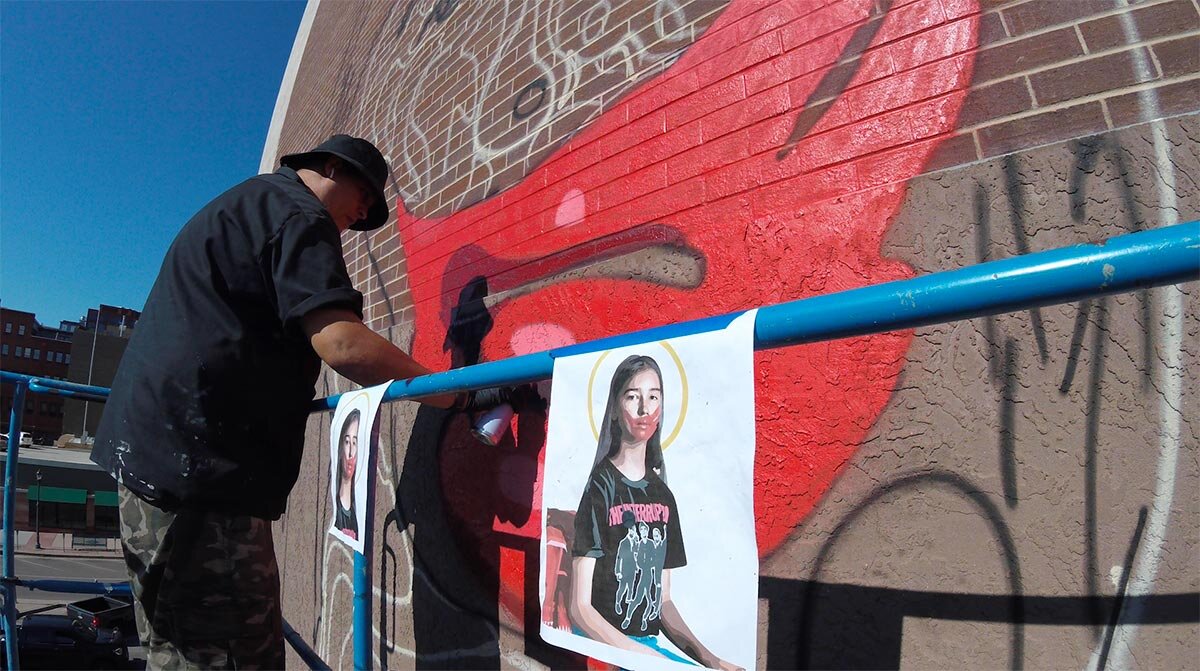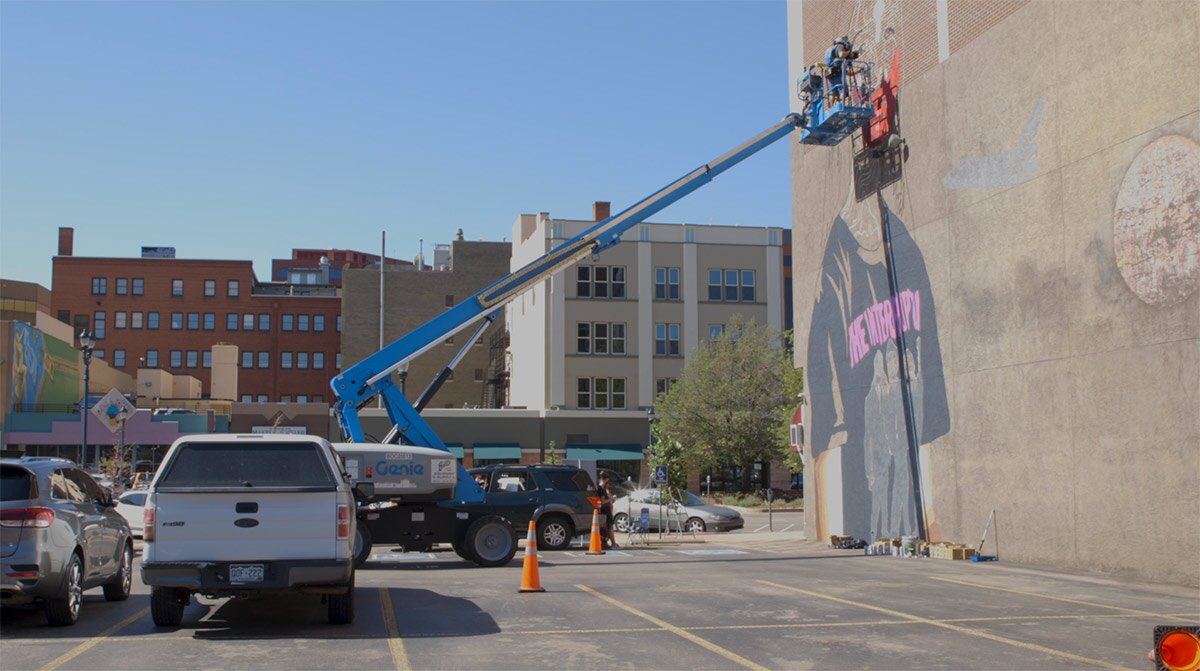New mural in Colorado addresses violence against Indigenous women, girls, and Two Spirit individuals

On a hot summer morning, in a parking lot near the Colorado Springs Pioneers Museum, several vehicles have a common Colorado bumper sticker: an image of a Colorado license plate, proclaiming, in capital letters, “NATIVE.”
The stickers imply superiority for those who were born in Colorado, opposed to transplants from out-of-state.
But to literal Native peoples of Indigenous descent, non-Native settlers are all relative newcomers. What is now Colorado Springs was once inhabited, or frequented, by nearly fifty Native tribes that had trade and cultural ties to the area for hundreds to thousands of years before colonization.
Misrepresenting that history is a cultural disservice, says Gregg Deal, an Indigenous activist and artist residing in Peyton, Colorado.
“There are Native people in this community that have been in this community for a long time,” says Gregg. “Spaces like Colorado Springs need to take that step, to engage the process of even just recognizing that Indigenous people were here before any sort of settlement or colonization happened.”
“I don’t know that Colorado Springs has ever really engaged in that conversation,” Gregg says. “But I suppose the best way to engage in that conversation… is to simply start it.”

Today, Gregg offers a sixty-foot-tall conversation starter via an original mural he has painted on an exterior wall at the corner of Tejon Street and Pikes Peak Avenue, in the heart of downtown Colorado Springs.
Supported by a telescopic boom lift and working day and night, Gregg brings an Indigenous experience to the forefront of the city scape. The mural, entitled “Take Back the Power,” is part of the 2020 Downtown Colorado Springs Art on the Streets public art program.
“It’s going to get hot today,” he laughs as the lift rises.
It’s the largest mural Gregg has ever painted — and it may even be the largest mural portrait honoring an Indigenous person in the United States.
Colorado entered statehood in 1876, five years after the city of Colorado Springs was officially colonized in 1871. Absent in many recollections of its celebratory foundation are the brutal means to the end that cleared the way for White settlers to capitalize on the area’s natural resources. The violent, blood-stained narrative of the genocide of the nation’s first peoples is often ignored.
“There’s an omission of history,” says Gregg. “And if we don’t talk about Native people in history, and their contributions, or even their existence within spaces that have been settled and colonized, then they don’t exist. And that does a disservice not only to American history, but also to indigenous people — particularly to youth, who are looking for representation of themselves in public spaces.”
The mural depicts a portrait of Gregg’s 14-year-old daughter, Sage, wearing a T-shirt of The Interrupters, her favorite band, while suffering a large red hand print over her entire mouth.
The red hand print is symbolic of a continuation of missing and murdered Indigenous women, says Gregg. It’s an epidemic in the United States and in Canada, where Native women remain disproportionately in danger of facing domestic abuse, sexual assault, rape, or murder.
According to a National Institute of Justice research report, more than four in five Native American and Alaska Native women suffer domestic or sexual violence at some point in their lives. And according to the US Department of Justice, at least 86% of reported cases of rape or sexual assault against Native women are inflicted by non-Native perpetrators.
“As an Indigenous person who cares about their relatives, and as a father who has two daughters, I care about their safety,” Gregg says.
Monycka Snowbird works with the Haseya Advocate Program, a Colorado Springs-based nonprofit. Her work serves El Paso County’s Native Americans suffering from domestic and sexual violence.
She says this disparity of justice exists in large part because of the absence of Federal investigation and prosecution when crimes are committed within the jurisdiction of Tribal Law. According to the National Institute of Justice, in 1978, the U.S. Supreme Court ruled that tribes did not have criminal jurisdiction over non-Native perpetrators. This means that federally recognized tribes have no authority to criminally prosecute non-Native offenders — even for crimes committed on Tribal lands.
Monycka’s work stands in prevention, as well as in memory of those lost. Like Sheree Barker, a Colorado Springs Native whose family is from the Standing Rock reservation. “Sheree is a local woman who was born, raised, and murdered here in Colorado Springs,” says Monycka. “She was killed in front of her six-year-old son.”
The Haseya Advocate Program provides support and advocacy for Native victims, and creates a Sister space for survivors in El Paso County. “We can hopefully prevent even one more missing or murdered Indigenous woman,” says Monycka. “We have to stop our sisters, our mothers, and our grandmas from being another statistic.”
According to the FBI’s National Crime Information Center, in 2017, 5,646 Native women were reported missing in the United States.
“It’s an epidemic,” says Gregg. “And because we’re such a small part of the demographics here in the United States, those statistics are not really followed or taken care of. We just kind of fall blind. And so I wanted to do a portrait that would have a significant nod towards the missing and murdered Indigenous women, girls and Two-spirit (LGBTQ), and also the intersection of just regular American life.”

Authentic representation of the modern Native experience, he says, means a lot to those who do not see their likeness reflected within the stereotypical underpinnings of the American representation of Native voices.
“That’s why you get into mascots, and you get into stereotypes, and all these other things that create a misrepresentation of Indigenous people,” Gregg says.
For Claire Swinford, Urban Engagement Manager for Downtown Colorado Springs and coordinator of Art on the Streets, the message is a necessary one to incorporate into downtown’s cultural sphere.
“This is a work that is truly site-specific,” says Claire. “Not only specifically created for the building that it’s on, but specific to this community. Being able to speak to the issue of missing and murdered Indigenous women, girls, and Two-spirit individuals within the context of how that plays out in El Paso County is immensely powerful.”
Gregg credits Claire and the Art on the Streets program for its perseverance in supporting Native dialogue and a visual presence downtown.
“I think we’re really lucky to have allies that are in spaces that recognize and realize they need to make room for these marginalized voices,” he says. “We’re seeing this across the country right now, with this national discussion of race and equity among people of color, particularly Black, Indigenous, Latinx, and even the gender spectrum. These are conversations that need to be happening, and I’m excited to be participating in that on some level.”